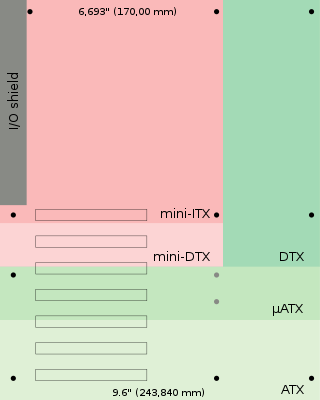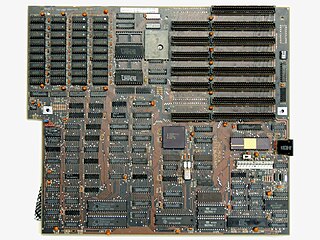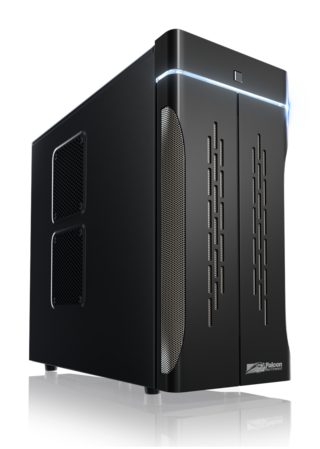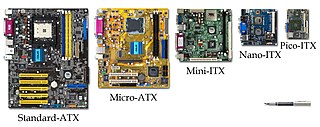
A motherboard is the main printed circuit board (PCB) in general-purpose computers and other expandable systems. It holds and allows communication between many of the crucial electronic components of a system, such as the central processing unit (CPU) and memory, and provides connectors for other peripherals. Unlike a backplane, a motherboard usually contains significant sub-systems, such as the central processor, the chipset's input/output and memory controllers, interface connectors, and other components integrated for general use.

ATX is a motherboard and power supply configuration specification, patented by David Dent in 1995 at Intel, to improve on previous de facto standards like the AT design. It was the first major change in desktop computer enclosure, motherboard and power supply design in many years, improving standardization and interchangeability of parts. The specification defines the dimensions; the mounting points; the I/O panel; and the power and connector interfaces among a computer case, a motherboard, and a power supply.

Mini-ITX is a 170 mm × 170 mm motherboard form factor developed by VIA Technologies in 2001. Mini-ITX motherboards have been traditionally used in small-configured computer systems. Originally, Mini-ITX was a niche standard designed for fanless cooling with a low power consumption architecture, which made them useful for home theater PC systems, where fan noise can detract from the cinema experience.
NLX was a form factor proposed by Intel and developed jointly with IBM, DEC, and other vendors for low profile, low cost, mass-marketed retail PCs. Release 1.2 was finalized in March 1997 and release 1.8 was finalized in April 1999. NLX was similar in overall design to LPX, including a riser card and a low-profile slimline case. It was modernized and updated to allow support for the latest technologies while keeping costs down and fixing the main problems with LPX. It specified motherboards from 10 × 8 in (254 × 203 mm) to 13.6 × 9 in (345 × 229 mm) in size.

BTX is a form factor for motherboards, originally intended to be the replacement for the aging ATX motherboard form factor in late 2004 and early 2005.

In the era of IBM compatible personal computers, the AT form factor comprises the dimensions and layout of the motherboard for the IBM AT. Baby AT motherboards are a little smaller, measuring 8.5" by 13". Like the IBM PC and IBM XT models before it, many third-party manufacturers produced motherboards compatible with the IBM AT form factor, allowing end users to upgrade their computers for faster processors. The IBM AT became a widely copied design in the booming home computer market of the 1980s. IBM clones made at the time began using AT compatible designs, contributing to its popularity. In the 1990s many computers still used AT and its variants. Since 1997, the AT form factor has been largely supplanted by ATX.

A computer case, also known as a computer chassis, is the enclosure that contains most of the hardware of a personal computer. The components housed inside the case are referred as the internal hardware, while hardware outside the case are known as peripherals.

In personal computing, a tower is a form factor of desktop computer case whose height is much greater than its width, thus having the appearance of an upstanding tower block, as opposed to a traditional "pizza box" computer case whose width is greater than its height and appears lying flat.

LPX, originally developed by Western Digital, was a loosely defined motherboard format widely used in the 1990s.

WTX was a motherboard form factor specification introduced by Intel at the IDF in September 1998, for its use at high-end, multiprocessor, multiple-hard-disk servers and workstations. The specification had support from major OEMs and motherboard manufacturers and was updated (1.1) in February 1999. As of 2008, the specification has been discontinued and the URL www.wtx.org no longer hosts a website and has not been owned by Intel since at least 2004.

In computer design, microATX is a standard motherboard form factor introduced in December 1997. The maximum size of a microATX motherboard is 9.6 × 9.6 in (244 × 244 mm). However, there are examples of motherboards using microATX designation despite having a smaller size of 244 × 205 mm (9.6 × 8.1 in). The standard ATX size is 25% longer, at 12 × 9.6 in (305 × 244 mm).

Small form factor is a term used for desktop computers and for some of its components, chassis and motherboard, to indicate that they are designed in accordance with one of several standardized computer form factors intended to minimize the volume and footprint of a desktop computer compared to the standard ATX form factor.

DFI is a Taiwanese industrial computer company with headquarters in Taipei. It designs, develops, manufactures, and sells industrial motherboard, industrial PCs, System-on-Module, industrial displays, and ODM/OEM services.

A power supply unit (PSU) converts mains AC to low-voltage regulated DC power for the internal components of a computer. Modern personal computers universally use switched-mode power supplies. Some power supplies have a manual switch for selecting input voltage, while others automatically adapt to the main voltage.
The Compact Electronics Bay Specification (CEB) as well as EEB, MEB and TEB are standard form factors for dual or multi processor motherboards defined by the Server System Infrastructure (SSI) Forum. The specification is intended for value servers and workstations based on the Intel Xeon, and AMD Epyc processors

The DTX form factor is a variation of ATX specification designed especially for small form factor PCs with dimensions of 8 × 9.6 inches (203 × 244 mm). An industry standard intended to enable interchangeability for systems similar to Shuttle's original "SFF" designs, AMD announced its development on January 10, 2007. AMD stated that the DTX form factor is an open standard, and is backward compatible with ATX form factor cases. They also present a shorter variant named Mini-DTX which is smaller in PCB size of 8 × 6.7 inches (203 × 170 mm).
The Power Good signal (power-good) is a signal provided by a computer power supply to indicate to the motherboard that all of the voltages are within specification and that the system may proceed to boot and operate.
In computing, the motherboard form factor is the specification of a motherboard – the dimensions, power supply type, location of mounting holes, number of ports on the back panel, etc. Specifically, in the IBM PC compatible industry, standard form factors ensure that parts are interchangeable across competing vendors and generations of technology, while in enterprise computing, form factors ensure that server modules fit into existing rackmount systems. Traditionally, the most significant specification is for that of the motherboard, which generally dictates the overall size of the case. Small form factors have been developed and implemented.

Mini ATX or Mini-ATX is a generic name that may be used by motherboard manufacturers to describe a small motherboard, and has been used by AOpen in reference to a motherboard design with dimensions 15 × 15 cm (5.9 × 5.9 in).
Small form factor is a term for computer components designed to a smaller than usual form factor.












